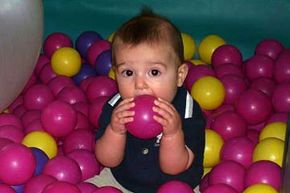Choosing from the Genetic Menu
The idea of manipulating the genes of humans should not surprise us. Scientists have been altering animal genes for years. Goats and cows have been manipulated so that they produce more milk or more proteins in their milk. Mice have been injected with genes that may cause Alzheimer's disease in an effort to find a cure. Jellyfish genes have been injected into the monkey genome.
One of the more interesting transgenic animals was created by injecting a spider gene into a goat's genome. Spider silk is very strong and, if produced in enough quantity, could create a very powerful type of body armor. And while spiders don't make enough silk to produce this super body armor, scientists discovered that spider silk is a protein similar to goat milk. When the spider gene is inserted into a goat, the goat produces a protein that is identical to that found in spider silk. This protein is extracted from the goat's milk to produce silk fibers, called BioSteel, which is used to make bulletproof vests.
Advertisement
Altering the genetic properties of living animals is a reality, and some of these animals have genetic makeups similar to that of humans. It's only a small leap from here to producing humans who can jump higher, see farther, hear better (or not at all) or run faster. Before these super humans can be created, though, we have to learn more about the human genetic code.
One method that could soon be used to change human genetics is called germline gene therapy. It involves adding a step to preimplantation genetic diagnosis. Germinal cells are our reproductive cells, and this approach means manipulating genes of the sperm, egg or early embryo. Beyond just screening embryos, germline therapy actually adds new genes to the cells. It's possible that almost any trait could be added to an embryo to create a tailor-made child.
Germline therapy is already being performed on animals. Genetic changes to germinal cells may not show up in the animal that results from the embryo, but may instead show up in later generations.
The long-term implications of germline therapy could be the elimination of disease and disability by simply "fixing" genetic problems as they arise. They could also be a bit darker -- a "Gattaca"-esque scenario in which only genetically perfect beings can advance in society. Or a nation develops super-human bullet-proof speedster soldiers and conquers the rest of the world for slave labor.
Either way, we can look forward to intense debate in the coming years over the acceptable applications of genetics discoveries. Will designing children to look, act and think a certain way become a commonplace approach to propagation?
Related HowStuffWorks Articles
More Great Links
Sources
- Keim, Brandon. "Designer Babies: A Right to Choose?" Wired. March 9, 2009.http://www.wired.com/wiredscience/2009/03/designerdebate/
- Le Page, Michael. "Fears over 'designer' babies leave children suffering." NewScientist. March 21, 2009.http://www.newscientist.com/article/mg20127006.600-fears-over-designer-babies-leave-children-suffering.html
- Naik, Guatam. "A Baby, Please. Blond, Freckles - Hold the Colic." The Wall Street Journal. Feb. 12, 2009.http://online.wsj.com/article/SB123439771603075099.html
- Savior siblings - the controversy and the technique. Telegraph. Aug. 10, 2009.http://www.telegraph.co.uk/health/healthnews/5999457/Saviour-siblings---the-controversy-and-the-technique.html
- Templeton, Sarah-Kate. "Deaf demand right to designer deaf children." TimesOnline. Dec. 23, 2007.http://www.timesonline.co.uk/tol/news/uk/health/article3087367.ece
